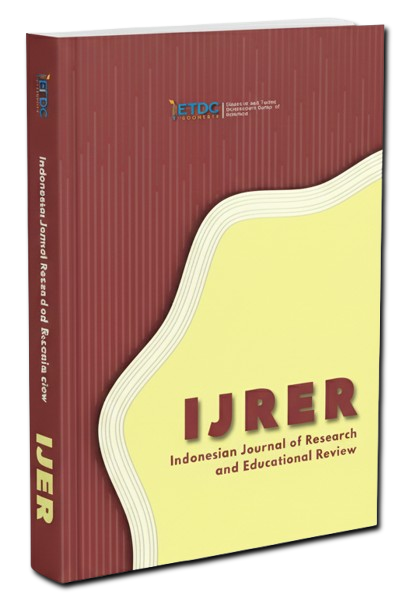Online Marketing Strategy in a Sharia Economic Perspective
https://doi.org/10.51574/ijrer.v2i1.1166
Keywords:
Diniya Sunnah Style Boutique's, Online Marketing, Strategy, Sharia EconomicsAbstract
The goal of this study is to investigate Diniya Sunnah Style Boutique's online marketing approach from a Sharia economic perspective to boost sales of Muslim clothing. The nature of this research is descriptive data obtained through descriptive research methods. Data obtained through interview, observation, documentation, and analysis of data obtained qualitatively is concluded using inductive thinking. The research results show that the marketing strategy implemented by Diniya Sunnah Style Boutique uses a marketing mix strategy that includes product strategy, price strategy, place strategy, and promotion strategy. Promotional strategies and product strategies are very influential in increasing sales at Diniya Sunnah Style Boutique. The online marketing strategy for Diniya Sunnah Style Boutique is following the greeting agreement of posting pictures including clear product specifications, and this of course increases consumer confidence in Diniya Sunnah Style Boutique.
References
Abbas, A., Nisar, Q. A., Mahmood, M. A. H., Chenini, A., & Zubair, A. (2020). The role of Islamic marketing ethics towards customer satisfaction. Journal of Islamic Marketing, 11(4), 1001-1018.
Anderson, J. M. (2013). Daily Life Through Trade: Buying and Selling in World History. Bloomsbury Publishing USA.
Belch, G. E., & Belch, M. A. (2018). Advertising and promotion: An integrated marketing communications perspective. mcgraw-hill.
Chong, A. Y. L., Ch’ng, E., Liu, M. J., & Li, B. (2017). Predicting consumer product demands via Big Data: the roles of online promotional marketing and online reviews. International Journal of Production Research, 55(17), 5142-5156.
Creswell, J. W., & Poth, C. N. (2016). Qualitative inquiry and research design: Choosing among five approaches. Sage publications.
Croes, R., Ridderstaat, J., Bąk, M., & Zientara, P. (2021). Tourism specialization, economic growth, human development and transition economies: The case of Poland. Tourism Management, 82, 104181.
Demil, B., Lecocq, X., Ricart, J. E., & Zott, C. (2015). Introduction to the SEJ special issue on business models: business models within the domain of strategic entrepreneurship. Strategic entrepreneurship journal, 9(1), 1-11.
Haas, R., Panzer, C., Resch, G., Ragwitz, M., Reece, G., & Held, A. (2011). A historical review of promotion strategies for electricity from renewable energy sources in EU countries. Renewable and sustainable energy reviews, 15(2), 1003-1034.
Hasan, M. (2020). Social marketing: an Islamic perspective. Journal of Islamic Marketing, 11(4), 863-881.
Henrekson, M., & Sanandaji, T. (2011). The interaction of entrepreneurship and institutions. Journal of institutional Economics, 7(1), 47-75.
Kacen, J. J., Hess, J. D., & Walker, D. (2012). Spontaneous selection: The influence of product and retailing factors on consumer impulse purchases. Journal of Retailing and Consumer Services, 19(6), 578-588.
Lewis, R. (2015). Muslim fashion: Contemporary style cultures. Duke University Press.
Li, X., Hitt, L. M., & Zhang, Z. J. (2011). Product reviews and competition in markets for repeat purchase products. Journal of Management Information Systems, 27(4), 9-42.
Mardani, D. (2015). Fiqh ekonomi syariah: Fiqh muamalah. Prenada Media.
Miller, D., & Le Breton-Miller, I. (2005). Managing for the long run: Lessons in competitive advantage from great family businesses. Harvard Business Press.
Mujib, A. (2017). Ekonomi Islam Global dalam Ranah Fiqh. Jurnal Masharif al-Syariah: Jurnal Ekonomi dan Perbankan Syariah, 2(2).
Nezamova, O., & Olentsova, J. (2020). The role of marketing in increasing competitiveness of the region. In Proceedings of the 2nd International Scientific Conference on Innovations in Digital Economy (pp. 1-6).
Pappas, N. (2016). Marketing strategies, perceived risks, and consumer trust in online buying behaviour. Journal of retailing and consumer services, 29, 92-103.
Pudjiraharjo, M., & Muhith, N. F. (2019). Fikih Muamalah Ekonomi Syariah. Universitas Brawijaya Press.
Pujianto, W. E. (2022). Digital Marketing in Sharia Perspective: A Literature Review. al-Uqud: Journal of Islamic Economics, 6(2).
Osterwalder, A., Pigneur, Y., Smith, A., & Etiemble, F. (2020). The invincible company: how to constantly reinvent your organization with inspiration from the world's best business models (Vol. 4). John Wiley & Sons.
Otto, A. S., Szymanski, D. M., & Varadarajan, R. (2020). Customer satisfaction and firm performance: insights from over a quarter century of empirical research. Journal of the Academy of Marketing science, 48, 543-564.
Setyowati, W., Widayanti, R., & Supriyanti, D. (2021). Implementation of e-business information system in indonesia: Prospects and challenges. International Journal of Cyber and IT Service Management, 1(2), 180-188.
Shifa, M. (2021). Analysis of Buying and Selling Practices Online in Islamic Law Perspective. Journal Research of Social, Science, Economics, and Management, 1(5), 467-476.
Tayibnapis, A. Z., Wuryaningsih, L. E., & Gora, R. (2018). The development of digital economy in Indonesia. IJMBS International Journal of Management and Business Studies, 8(3), 14-18.
Twigg, J. (2013). Fashion and age: Dress, the body and later life. A&C Black.
Varadarajan, R. (2020). Customer information resources advantage, marketing strategy and business performance: A market resources based view. Industrial Marketing Management, 89, 89-97.
Veleva, S. S., & Tsvetanova, A. I. (2020). Characteristics of the digital marketing advantages and disadvantages. In IOP Conference Series: Materials Science and Engineering (Vol. 940, No. 1, p. 012065). IOP Publishing.
Wilson, J. A., & Grant, J. (2013). Islamic marketing–a challenger to the classical marketing canon?. Journal of Islamic Marketing, 4(1), 7-21.
Downloads
Published
How to Cite
Issue
Section
License
Copyright (c) 2024 ETDC: Indonesian Journal of Research and Educational Review

This work is licensed under a Creative Commons Attribution-ShareAlike 4.0 International License.


























